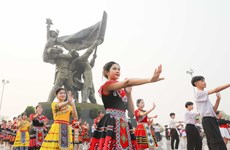Nam Dinh to seek UNESCO recognition for musical genre
The Ministry of Culture, Sports and Tourism has asked the northern
province of Nam Dinh to compile a dossier seeking UNESCO’s recognition
of the Chau Van (spiritual singing) ritual as a piece of intangible
cultural heritage of humanity.
The Ministry of Culture, Sports and Tourism has asked the northern
province of Nam Dinh to compile a dossier seeking UNESCO’s recognition
of the Chau Van (spiritual singing) ritual as a piece of intangible
cultural heritage of humanity.
Chau Van, which has national heritage status already, was created during the Tran Dynasty (1225-1400) and Nam Dinh province is considered its birthplace.
The highly rhythmic and trance-oriented form of singing often takes place during rituals to honour the Mother Goddesses and connect to other gods. It is performed mostly at temples and pagodas.
The music and poetry performed in the folk art are mingled with a variety of rhythms, pauses, tempos, stresses and pitches. The genre has also adopted folk songs from the highlands of the north, centre and south. The main musical instrument used in the genre is Dan Nguyet (moon-shaped lute).
Vietnam now has seven examples of world intangible heritage listed by UNESCO, namely Hue's royal court music; Gong space culture in the Central Highlands; Quan ho (love duet) singing; the Giong festival; Ca Tru ceremonial singing; Xoan singing; and the Worship of the nation founders Hung Kings.-VNA
Chau Van, which has national heritage status already, was created during the Tran Dynasty (1225-1400) and Nam Dinh province is considered its birthplace.
The highly rhythmic and trance-oriented form of singing often takes place during rituals to honour the Mother Goddesses and connect to other gods. It is performed mostly at temples and pagodas.
The music and poetry performed in the folk art are mingled with a variety of rhythms, pauses, tempos, stresses and pitches. The genre has also adopted folk songs from the highlands of the north, centre and south. The main musical instrument used in the genre is Dan Nguyet (moon-shaped lute).
Vietnam now has seven examples of world intangible heritage listed by UNESCO, namely Hue's royal court music; Gong space culture in the Central Highlands; Quan ho (love duet) singing; the Giong festival; Ca Tru ceremonial singing; Xoan singing; and the Worship of the nation founders Hung Kings.-VNA












